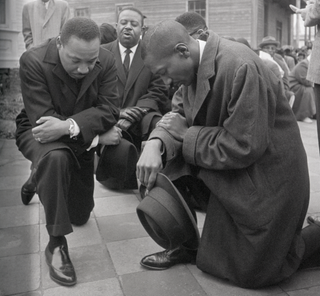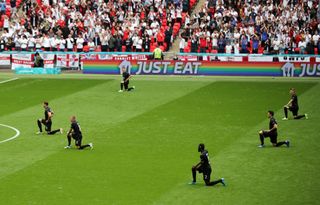Where did taking the knee come from? Origins of the gesture and how to explain it to children


Where did taking the knee come from? As the Euros 2020 are now over, attention is turning to some of the pivotal moments of the tournament.
At the beginning of every game, just before the whistle blew, members of the England football team went down on one knee as a sign of solidarity with the Black Lives Matter movement. Much to the embarrassment of the rest of the country, fans booed players taking this move during the early stages of the tournament. Senior politicians have also publicly looked down on the act. Home Secretary Priti Patel referred to taking the knee as "gesture politics" while another Tory politician said he would boycott England's games.
So where did taking the knee come from? And as calls to diversify school syllabuses and talk to children about racism continue, how do you explain taking the knee to children?
Where did taking the knee come from?
The idea of taking the knee - going down on one knee as a protest - has a long history. It's steeped in the American civil rights movement. Martin Luther King, arguably the most famous civil rights activist of the 1950s and 60s, took the knee in Alabama in 1965 to show solidarity with protestors.
The act was iconised in 2016 when NFL stars Colin Kaepernick, Eli Harold and Eric Reid knelt down on one knee during the American national anthem before a game. At the time Kaepernick said, “I am not going to stand up to show pride in a flag for a country that oppresses black people and people of colour. To me, this is bigger than football and it would be selfish on my part to look the other way.

“There are bodies in the street and people getting paid leave and getting away with murder”
This was in reference to how police officers who kill Black people on duty are rarely prosecuted for the crime. Instead, they lose their job or are suspended on paid leave. In 2016 alone for example, at least 232 Black people died as a direct result of police action in the US. This number includes the high profile killings of Alton Sterling, who was killed by police in Baton Rouge, Louisiana, and Philando Castile, killed by police in Falcon Heights, Minnesota. In both cases, either no charges were filed or the officers were acquitted.
GoodtoKnow Newsletter
Parenting advice, hot topics, best buys and family finance tips delivered straight to your inbox.
This was just two years after the death of Eric Garner, killed by police in New York. His last words, "I can't breathe", have been used as verbal protest against violent, institutional racism ever since.
The NFL players' move received huge amounts of backlash from the public, the NFL and former President Donald Trump. However, following the murder of George Floyd by police in Minneapolis last year, an event which sparked waves of protests across the world, the gesture was given a firm place in sport.

Players take the knee before events as a sign of protest and solidarity with the Black Lives Matter movement. In England last year, all 22 players and the referee of the Premier League match post-lockdown took the knee. And most recently in the Euros 2020, England and other European teams involved in the tournament took the knee before every game.
Despite the clear meaning behind the move, the stance received backlash from England fans who booed players. Some senior politicians also made their opinions clear, including Conservative MP Lee Anderson. He said would boycott England's games in the Euros because of players' decision to take the knee.
Adding that the England team was supporting a "political movement", he said they were alienating "traditional supporters".
“For the first time in my life I will not be watching my beloved England team whilst they are supporting a political movement whose core principles aim to undermine our very way of life,” he said. However, he later confirmed that he would be checking the scores on his phone.
The Football Association (FA) said in a statement that the "gesture of unity and fighting against inequality" is "not new" as it stretches as far back as the 18th century.
"There can be no doubt as to why the players are taking the knee and what it represents in a footballing context. We encourage those that oppose this action to reflect on the message you are sending to the players you are supporting."
On June 17 2020, the phrase take the knee also made its way into the Cambridge Dictionary, clarifying the meaning and origin of the phrase.
While taking the knee has been iconised by sports stars, it isn't just a sports-related sign of protest. The origins of the gesture remind us of this. Black Lives Matter protests also continue to take place around the world today. During these, people have been taking the knee in the streets as a sign of peaceful protest. Just as Martin Luther King did in 1965.

How to explain taking a knee to children
Since the death of George Floyd in Minneapolis last year, there have been calls to diversify children’s education. In turn, this would help them understand the prejudices facing Black people around the world. A huge part of this is the understanding that children need to be raised to be anti-racist. The responsibility of this lands on parents and schools. They have been advised to take it upon themselves to make institutional changes and to educate children about racism.
So how do you explain taking the knee to children? While you might not think that children have picked up on something like taking a knee, experts from the American Psychological Association suggest that children will actually know more it than you might think. They might have seen it on the news, social media or on the front of a newspaper. Either way, the chances are they’ve seen something and they might have questions.
If your child is a sports fan, you might want to take the Euros 2020 as a teaching moment. So, it’s important to know where to start.
The Positive Coaching Alliance is an organisation is the US dedicated to creating a “positive, character-building youth sports environment that results in better athletes, better people”. When debate began around athletes taking the knee, they released advice for parents.
Start by asking questions
Start by asking your child questions – rather than giving a lengthy explanation of where you personally stand on the issue. If you go first, you may never hear what your child thinks. You’ll learn a lot by letting them speak first.
This is also about making sure you give them information that they can understand linguistically. As Roger Harrison, PhD, pediatric psychologist at Nemours/Alfred I.duPont Hospital for Children told the Philadelphia Inquirer in 2017, “Rather than trying to explain the whole history of race relations and athletic activism in America, you want to provide the simplest answer or explanation at a level appropriate to the child's development.”
Use the resources available to you
If you want to learn alongside your child, there are plenty of materials out there for you to use. Along with surges in adult books about racism, there has also been a huge uplift in purchases of children's books about race.
‘The Hero In The Helmet: Colin Kaepernick’ is a children’s picture book, written by Joa Macnalie and published in 2018. It aims to teach children about the life and legacy of the NFL player.
One Amazon customer said the book had “well written verses and engaging illustrations”. Another commented, “Great discussion questions and glossary in the back to aid in conversations with children and adults! A must have for your library.”
Realise it’s okay not to have all the answers
“It’s OK to model not having all the answers,” the Positive Coaching Alliance advises. They suggest that parents could say instead, “This is a really tough topic. Let’s talk about what’s happening and figure out how we feel about it together.”
Showing your child that you might not have all the answers is no bad thing. By answering their questions anyway, you're also encouraging them to come to you in the future with difficult things.

Grace Walsh is a health and wellbeing writer, working across the subjects of family, relationships, and LGBT topics, as well as sleep and mental health. A digital journalist with over six years experience as a writer and editor for UK publications, Grace is currently Health Editor for womanandhome.com and has also worked with Cosmopolitan, Red, The i Paper, GoodtoKnow, and more. After graduating from the University of Warwick, she started her career writing about the complexities of sex and relationships, before combining personal hobbies with professional and writing about fitness.
-
 Staying together 'for the kids' can have damaging consequences - divorce therapist explains 3 reasons why
Staying together 'for the kids' can have damaging consequences - divorce therapist explains 3 reasons whyThree major consequences of staying in a failing relationship have been identified - we share what they are, and why staying together can be more damaging for your children.
By Lucy Wigley Published
-
 Record number of families opt-out of claiming child benefit, but the decision could have serious repercussions for your future
Record number of families opt-out of claiming child benefit, but the decision could have serious repercussions for your futureStark warning for families as number of parents who opt-out of receiving child benefit reaches 10-year high
By Sarah Handley Published